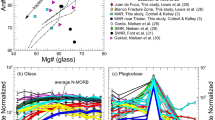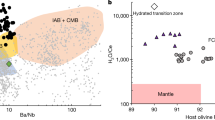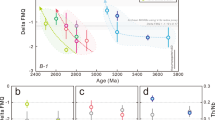Abstract
The early Earth’s mantle is believed to have been highly reducing when it formed from a magma ocean equilibrating with the core. Conversely, some geological evidence suggests that the Hadean upper mantle was oxidized to a similar degree as or even more than that of today. Previous work on the high-pressure melting of andesite demonstrated the disproportionation of Fe2+ to Fe3+ plus Fe0 in the melt, suggesting the magma ocean became more oxidized as Fe0 was removed into the core. Here we present results of experiments melting peridotite at pressures to 28 GPa, that of the uppermost lower mantle. We show the Fe3+ content of Earth’s magma ocean was an order of magnitude greater than that of the present upper mantle if the magma ocean reached the lower mantle, which quantitatively explains the geological evidence for a highly oxidized Hadean mantle. This Hadean great mantle oxidation should have ended with the cessation of the huge impacts that sustained a deep magma ocean. The subsequent reduction in Fe3+ content and oxidation state of the upper mantle may be attributed to the accretion of reduced materials by small impactors in late Hadean and early Archaean eons.
This is a preview of subscription content, access via your institution
Access options
Access Nature and 54 other Nature Portfolio journals
Get Nature+, our best-value online-access subscription
$29.99 / 30 days
cancel any time
Subscribe to this journal
Receive 12 print issues and online access
$259.00 per year
only $21.58 per issue
Buy this article
- Purchase on Springer Link
- Instant access to full article PDF
Prices may be subject to local taxes which are calculated during checkout



Similar content being viewed by others
Data availability
The datasets for this research are available within the article and its Supplementary Information or Zenodo (https://doi.org/10.5281/zenodo.7645165). Source data are provided with this paper.
Change history
02 January 2024
A Correction to this paper has been published: https://doi.org/10.1038/s41561-023-01363-4
References
Kasting, J. F. Earth’s early atmosphere. Science 259, 920–926 (1993).
Hirschmann, M. M. Magma ocean influence on early atmosphere mass and composition. Earth Planet. Sci. Lett. 341-344, 48–57 (2012).
Gaillard, F. & Scaillet, B. A theoretical framework for volcanic degassing chemistry in a comparative planetology perspective and implications for planetary atmospheres. Earth Planet. Sci. Lett. 403, 307–316 (2014).
Stribling, R. & Miller, S. L. Energy yields for hydrogen cyanide and formaldehyde syntheses: the HCN and amino acid concentrations in the primitive ocean. Orig. Life Evol. Biosph. 17, 261–273 (1987).
Tian, F., Toon, O. B., Pavlov, A. A. & Sterck, H. D. A hydrogen-rich early Earth atmosphere. Science 308, 1014–1017 (2005).
Frost, D. J., Mann, U., Asahara, Y. & Rubie, D. C. The redox state of the mantle during and just after core formation. Phil. Trans. R. Soc. A 366, 4315–4337 (2008).
Trail, D., Watson, E. B. & Tailby, N. D. The oxidation state of Hadean magmas and implications for early Earth’s atmosphere. Nature 480, 79–82 (2011).
Armstrong, K., Frost, D. J., McCammon, C. A., Rubie, D. C. & Ballaran, T. B. Deep magma ocean formation set the oxidation state of Earth’s mantle. Science 365, 903–906 (2019).
Deng, J., Du, Z., Karki, B. B., Ghosh, D. B. & Lee, K. M. A magma ocean origin to divergent redox evolutions of rocky planetary bodies and early atmospheres. Nat. Commun. 11, 2007 (2020).
Mao, H.-K. A discussion of the iron oxides at high pressures with implications for the chemical and thermal evolution of the Earth. Carnegie Inst. Wash. Yearbook 73, 510–518 (1974).
Ringwood, A. E. Composition of the core and implications for origin of the Earth. Geochem. J. 11, 111–135 (1977).
Frost, D. J. et al. Experimental evidence for the existence of iron-rich metal in the Earth’s lower mantle. Nature 428, 409–412 (2004).
Zhang, H. L., Hirschmann, M. M., Cottrell, E. & Withers, A. C. Effect of pressure on Fe3+/ΣFe ratio in a mafic magma and consequences for magma ocean redox gradients. Geochim. Cosmochim. Acta 204, 83–103 (2017).
Kress, V. C. & Carmichael, I. S. E. The compressibility of silicate liquids containing Fe2O3 and the effect of composition, temperature, oxygen fugacity and pressure on their redox states. Contrib. Mineral. Petrol. 108, 82–92 (1991).
Li, J. & Agee, C. B. Geochemistry of mantle–core differentiation at high pressure. Nature 381, 686–689 (1996).
Righter, K. Prediction of metal–silicate partition coefficients for siderophile elements: an update and assessment of PT conditions for metal–silicate equilibrium during accretion of the Earth. Earth Planet. Sci. Lett. 304, 158–167 (2011).
Zhou, Y., Irifune, T. & Kuribayashi, T. New high-pressure forms of Al2SiO5. Geophys. Res. Lett. 45, 8167–8172 (2018).
Takahashi, E. Melting of a dry peridotite KLB-1 up to 14 GPa: implications on the origin of peridotitic upper mantle. J. Geophys. Res. 91, 9367–9382 (1986).
Yasuda, A., Fujii, T. & Kurita, K. Melting phase relations of an anhydrous mid-ocean ridge basalt from 3 to 20 GPa: implications for the behavior of subducted oceanic crust in the mantle. J. Geophys. Res. 99, 9401–9414 (1994).
Tschauner, O. et al. Ultrafast growth of wadsleyite in shock-produced melts and its implications for early Solar System impact processes. Proc. Natl Acad. Sci. USA 106, 13691–13695 (2009).
Guillot, B. & Sator, N. A computer simulation study of natural silicate melts. Part II: high pressure properties. Geochim. Cosmochim. Acta 71, 4538–4556 (2007).
Berry, A. J. & O’Neill, H. S. C. A XANES determination of the oxidation state of chromium in silicate glasses. Am. Mineral. 89, 790–798 (2004).
Canil, D. et al. Ferric iron in peridotites and mantle oxidation states. Earth Planet. Sci. Lett. 123, 205–220 (1994).
Cottrell, E. & Kelley, K. A. The oxidation state of Fe in MORB glasses and the oxygen fugacity of the upper mantle. Earth Planet. Sci. Lett. 305, 270–282 (2011).
Frost, D. J. & McCammon, C. A. The redox state of Earth’s mantle. Annu. Rev. Earth Planet. Sci. 36, 389–420 (2008).
Bajgain, S., Ghosh, D. B. & Karki, B. B. Structure and density of basaltic melts at mantle conditions from firsr-principles simulations. Nat. Commun. 6, 8578 (2015).
Wade, J. & Wood, B. J. Core formation and the oxidation state of the Earth. Earth Planet. Sci. Lett. 236, 78–95 (2005).
Siebert, J., badro, J., Antonangeli, D. & Ryerson, F. J. Terrestrial accretion under oxidizing conditions. Science 339, 1194–1197 (2013).
Fischer, R. A. et al. High pressure metal–silicate partitioning of Ni, Co, V, Cr, Si, and O. Geochim. Cosmochim. Acta 167, 177–194 (2015).
Nakajima, M. et al. Scaling laws for the geometry of an impact-induced magma ocean. Earth Planet. Sci. Lett. 568, 116983 (2021).
Andrault, D. et al. Solidus and liquidus profiles of chondritic mantle: implication for melting of the Earth across its history. Earth Planet. Sci. Lett. 304, 251–259 (2011).
Lebrun, T. et al. Thermal evolution of an early magma ocean in interaction with the atmosphere. J. Geophys. Res. Planets 118, 1155–1176 (2013).
Rubie, D. C., Melosh, H. J., Reid, J. E., Liebske, C. & Righter, K. Mechanisms of metal–silicate equilibration in the terrestrial magma ocean. Earth Planet. Sci. Lett. 205, 239–255 (2003).
Ichikawa, H., Labrosse, S. & Kurita, K. Direct numerical simulation of an iron rain in the magma ocean. J. Geophys. Res. 115, B01404 (2011).
Gaillard, F. et al. Redox controls during magma ocean degassing. Earth Planet. Sci. Lett. 577, 117255 (2022).
Li, Z.-X. A. & Lee, C.-T. A. The constancy of upper mantle fO2 through time inferred from V/Sc ratios in basalts. Earth Planet. Sci. Lett. 228, 483–493 (2004).
Aulbach, S. & Stagno, V. Evidence for a reducing Archean ambient mantle and its effects on the carbon cycle. Geology 44, 751–754 (2016).
Nicklas, R. W., Puchtel, I. S. & Ash, R. D. Redox state of the Archean mantle: evidence from V partitioning in 3.5–2.4 Ga komatiites. Geochim. Cosmochim. Acta 222, 447–466 (2018).
Nicklas, R. W. et al. Secular mantle oxidation across the Archean–Proterozoic boundary: evidence from V partitioning in komatiites and picrites. Geochim. Cosmochim. Acta 250, 49–75 (2019).
Marchi, S. et al. Widspread mixing and burial of Earth’s Hadean crust by asteroid impacts. Nature 511, 578–582 (2014).
Miyazaki, Y. & Korenaga, J. A wet heterogeneous mantle creates a habitable world in the Hadean. Nature 603, 86–90 (2022).
Dauphas, N. The isotopic nature of the Earth’s accreting material through time. Nature 541, 521–523 (2017).
Yang, X., Gaillard, F. & Scaillet, B. A relatively reduced Hadean continental crust and implications for the early atmosphere and crustal rheology. Earth Planet. Sci. Lett. 393, 210–219 (2014).
Shim, S.-H. et al. Stability of ferrous-iron-rich bridgmanite under reducing midmantle conditions. Proc. Natl Acad. Sci. USA 114, 6468–6473 (2017).
Andrault, D. et al. Large oxygen excess in the primitive mantle could be the source of the great oxygenation event. Geochem. Perspect. Lett. 6, 5–10 (2018).
Wang, X., Tsuchiya, T. & Hase, A. Computational support for a pyrolytic lower mantle containing ferric iron. Nat. Geosci. 8, 556–559 (2015).
Mashino, I., Murakami, M., Miyajima, N. & Petitgirard, S. Experimental evidence for silica-enriched Earth’s lower mantle with ferrous iron dominant bridgmanite. Proc. Natl Acad. Sci. USA 117, 27899–27905 (2020).
Hirschmann, M. M. Magma oceans, iron and chromium redox, and the origin of comparatively oxidized planetary mantles. Geochim. Cosmochim. Acta 328, 221–241 (2022).
Jacobsen, S. B. The Hf-W isotopic system and the origin of the Earth and Moon. Annu. Rev. Earth Planet. Sci. 33, 531–570 (2005).
Fei, Y. et al. Experimentally determined postspinel transformation boundary in Mg2SiO4 using MgO as an internal pressure standard and its geophysical implications. J. Geophys. Res. 109, B02305 (2004).
Katsura, T. et al. Olivine–wadsleyite transition in the system (Mg,Fe)2SiO4. J. Geophys. Res. 109, B02209 (2004).
Tsujino, N. et al. Phase transition of wadsleyite–ringwoodite in the Mg2SiO4–Fe2SiO4 system. Am. Mineral. 104, 588–594 (2019).
Hirose, K., Komabayashi, T., Murakami, M. & Funakoshi, K. In-situ measurements of the majorite–akimotite–perovskite phase transition boundaries in MgSiO3. Geophys. Res. Lett. 28, 4351–4354 (2001).
Nomura, R., Zhou, Y. & Irifune, T. Melting phase relations in the MgSiO3–CaSiO3 system at 24 GPa. Prog. Earth Planet. Sci. 4, 34 (2017).
Zhou, Y., Irifune, T. & Ohfuji, H. Stability region of K0.2Na0.8AlSi3O8 hollandite at 22 GPa and 2273 K. Phys. Chem. Miner. 44, 33–42 (2017).
Jochum, K. P. et al. MPI-DING reference glasses for in situ microanalysis: new reference values for element concentrations and isotope ratios. Geochem. Geophys. Geosyst. https://doi.org/10.1029/2005gc001060 (2006).
Kuwahara, H., Itoh, S., Nakada, R. & Irifune, T. The effects of carbon concentration and silicate composition on the metal–silicate partitioning of carbon in a shallow magma ocean. Geophys. Res. Lett. 46, 9422–9429 (2019).
Kuwahara, H., Itoh, S., Suzumura, A., Nakada, R. & Irifune, T. Nearly carbon-saturated magma oceans in planetary embryos during core formation. Geophys. Res. Lett. 48, e2021GL092389 (2021).
Nakada, R., Sato, M., Ushioda, M., Tamura, Y. & Yamamoto, S. Variation of iron species in plagioclase crystals by X-ray absorption fine structure analysis. Geochem. Geophys. Geosyst. 20, 5319–5333 (2019).
Holzheid, A., Palme, H. & Chakraborty, S. The activities of NiO, CoO and FeO in silicate melts. Chem. Geol. 139, 21–38 (1997).
Lange, R. A. & Carmichael, I. S. E. Densities of Na2O–K2O–CaO–MgO–FeO–Fe2O3–Al2O3–TiO2–SiO2 liquids: new measurements and derived partial molar properties. Geochim. Cosmochim. Acta 51, 2931–2946 (1987).
Miller, G. H., Stolper, E. M. & Ahrens, T. J. The equation of state of a molten komatiite 1. Shock wave compression to 36 GPa. J. Geophys. Res. 96, 11831–11848 (1991).
Frost, D. J. et al. Partitioning of oxygen between the Earth’s mantle and core. J. Geophys. Res. 115, B02202 (2010).
Komabayashi, T. Thermodynamics of melting relations in the system Fe–FeO at high pressure: implications for oxygen in the Earth’s core. J. Geophys. Res. 119, 4164–4177 (2014).
McDonough, W. F. & Sun, S.-S. The composition of the Earth. Chem. Geol. 120, 223–253 (1995).
Acknowledgements
The XANES measurements were conducted at BL27SU of SPring-8 (proposal numbers 2020A1313, 2021A1206, 2021B1664 and 2022A1302). K. Nitta and H. Suga are acknowledged for XANES measurements. We thank M. C. Wood for making corrections to English in the paper. This study was supported by the Japan Society of the Promotion of Science (JSPS) KAKENHI to H.K. (grant numbers 20H01994 and 21K18655).
Author information
Authors and Affiliations
Contributions
H.K. conceived the idea and designed the study with R.N. H.K. conducted high-pressure experiments, EPMA analysis and thermodynamic calculation. R.N. conducted XANES measurements and analysed data. H.K. interpreted data and wrote the paper with the help of R.N., S.K., T.Y. and T.I. All authors discussed the results and commented on the paper.
Corresponding author
Ethics declarations
Competing interests
The authors declare no competing interests.
Peer review
Peer review information
Nature Geoscience thanks Katherine Armstrong, Fabrice Gaillard and the other, anonymous, reviewer(s) for their contribution to the peer review of this work. Primary Handling Editor: Stefan Lachowycz, in collaboration with the Nature Geoscience team.
Additional information
Publisher’s note Springer Nature remains neutral with regard to jurisdictional claims in published maps and institutional affiliations.
Extended data
Extended Data Fig. 1 Back-scattered electron images and XANES spectra of recovered samples.
a–c Peridotitic melt at 15 GPa and 2673 K (Run No. OS3781). d–f Peridotitic melt at 21 GPa and 2773 K (Run No. 5k3510). g–i Peridotitic melt at 23 GPa and 2873 K (Run No. 1k3305).
Extended Data Fig. 2 Back-scattered electron images and XANES spectra of recovered samples.
a–c Peridotitic melt at 24 GPa and 2773 K (Run No. 1k3254). d–f Peridotitic melt at 27 GPa and 2873 K (Run No. 1k3266). g–i Peridotitic melt at 28 GPa and 2873 K (Run No. OT2846).
Extended Data Fig. 3 Back-scattered electron images and XANES spectra of recovered samples.
a–c Basaltic melt at 21 GPa and 2773 K (Run No. 5k3510). d–f Basaltic melt at 24 GPa and 2773 K (Run No. 1k3254). g–i Basaltic melt at 27 GPa and 2873 K (Run No. 1k3266).
Extended Data Fig. 4 Sub-μm sized metal droplets in the recovered samples.
a Peridotitic melt quenched from 28 GPa and 2873 K (Run No. OT2775) b Basaltic melt quenched from 27 GPa and 2873 K (Run No. 1k3266). Left figure is the back-scattered electron image and right figure shows Fe map taken by FE-SEM with an energy-dispersive spectrometer (EDS). Arrows indicate identified metal droplets.
Extended Data Fig. 5 An example image for estimating the area fraction of metallic droplets probably formed during quenching from 28 GPa and 2873 K (Run No. OT2846).
Red regions in b indicate identified metallic droplets (0.23 % area fraction) using ImageJ.
Extended Data Fig. 6 The XANES spectra of iron oxides.
a synthesized fayalite (Fe2SiO4) (Fe3+/ΣFe ratio = −0.013). b synthesized hematite (Fe2O3) (Fe3+/ΣFe ratio = 0.997).
Supplementary information
Supplementary Table 1
Chemical composition (wt%) of the recovered samples.
Source data
Source Data Fig. 2
Source Data Fig. 2.
Source Data Fig. 3
Source Data Fig. 3.
Rights and permissions
Springer Nature or its licensor (e.g. a society or other partner) holds exclusive rights to this article under a publishing agreement with the author(s) or other rightsholder(s); author self-archiving of the accepted manuscript version of this article is solely governed by the terms of such publishing agreement and applicable law.
About this article
Cite this article
Kuwahara, H., Nakada, R., Kadoya, S. et al. Hadean mantle oxidation inferred from melting of peridotite under lower-mantle conditions. Nat. Geosci. 16, 461–465 (2023). https://doi.org/10.1038/s41561-023-01169-4
Received:
Accepted:
Published:
Issue Date:
DOI: https://doi.org/10.1038/s41561-023-01169-4
This article is cited by
-
Oxygen-rich melt in deep magma oceans
Nature Geoscience (2023)



